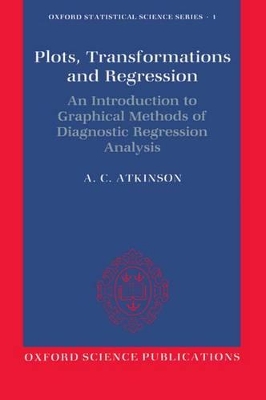Oxford Statistical Science
2 primary works
Book 1
`Repression diagnostics are a collection of methods used to find (diagnose) unusual features in a regression problem.
`Although informal diagnostics have a long and respectable history, it is only in the last fifteen years or so that they have been systematically studied. Atkinson has been one of the key players in this area, with several important papers dating from the early 1970s. The book clearly builds on much of that earlier work, but it is not intended as a research monograph, but as an introduction and guide to using diagnostics as a practical part of regression analysis. Both research statisticians
and users of statistics should find this book generally both interesting and accessible.
`A major strength of this book is Atkinson's decision to present only a subset of diagnostic methods that have been suggested in the literature, rather than giving the reader a menu of possibilities to choose from. In a field with few underlying principles and much that requires experience and practice, the reader who is new to the area can only benefit from learning a reasonably coherent collection of methods.' From a review by Sanford Weisberg, University of Minnesota.
`Although informal diagnostics have a long and respectable history, it is only in the last fifteen years or so that they have been systematically studied. Atkinson has been one of the key players in this area, with several important papers dating from the early 1970s. The book clearly builds on much of that earlier work, but it is not intended as a research monograph, but as an introduction and guide to using diagnostics as a practical part of regression analysis. Both research statisticians
and users of statistics should find this book generally both interesting and accessible.
`A major strength of this book is Atkinson's decision to present only a subset of diagnostic methods that have been suggested in the literature, rather than giving the reader a menu of possibilities to choose from. In a field with few underlying principles and much that requires experience and practice, the reader who is new to the area can only benefit from learning a reasonably coherent collection of methods.' From a review by Sanford Weisberg, University of Minnesota.
Book 8
A well-designed experiment is an efficient method of learning about the world. Because experiments in the field and in the laboratory cannot avoid random error, statistical methods are essential for their efficient design and analysis. In this book, the fundamentals of optimum experimental design theory are presented. In the first part of the part of the book, the advantages of a statistical approach to the design of experiments are discussed, and the ideas of
models, least squares fitting, and optimum experimental designs are introduced. The second part presents a more detailed discussion of the general theory of optimum design and an evaluation of various criteria that may be appropriate for designing experiments. Specific experiments are detailed and
algorithms for the construction of designs are given.
Each chapter is a self-contained topic, illustrated with examples drawn from science and engineering. Little previous statistical knowledge is assumed, and the derivation of mathematical results has been avoided. This book should be of interest to everyone concerned with designing efficient experiments in the laboratory or in the industry.
models, least squares fitting, and optimum experimental designs are introduced. The second part presents a more detailed discussion of the general theory of optimum design and an evaluation of various criteria that may be appropriate for designing experiments. Specific experiments are detailed and
algorithms for the construction of designs are given.
Each chapter is a self-contained topic, illustrated with examples drawn from science and engineering. Little previous statistical knowledge is assumed, and the derivation of mathematical results has been avoided. This book should be of interest to everyone concerned with designing efficient experiments in the laboratory or in the industry.

